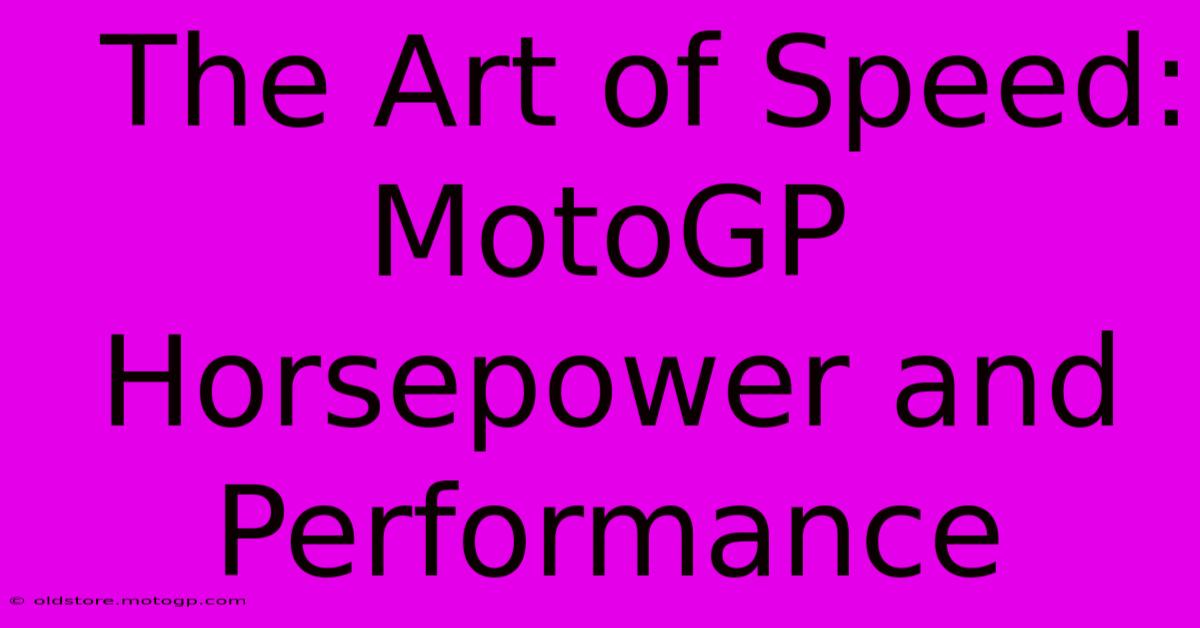The Art Of Speed: MotoGP Horsepower And Performance

Table of Contents
The Art of Speed: MotoGP Horsepower and Performance
The roar of the engines, the blur of speed, the breathtaking maneuvers – MotoGP embodies the pinnacle of motorcycle racing. But what fuels this exhilarating spectacle? It's a complex interplay of horsepower, cutting-edge technology, and the sheer skill of the riders. This article delves into the heart of MotoGP, exploring the horsepower and performance aspects that make it so captivating.
Unleashing the Beasts: MotoGP Engine Power
MotoGP bikes aren't your average motorcycles. These finely tuned machines are powerhouses, boasting incredible horsepower figures. While exact numbers vary slightly depending on the manufacturer and regulations, we're talking about power outputs exceeding 260 bhp. That's enough to launch these lightweight machines to incredible speeds, easily exceeding 200 mph on certain straights.
The Evolution of Power: From 500cc Two-Strokes to Modern Prototypes
The history of MotoGP horsepower is a fascinating journey. The era of 500cc two-stroke engines was legendary for its raw power and screaming exhaust notes, though these bikes were notoriously difficult to handle. The transition to the current 1000cc four-stroke prototypes brought significant changes. While the two-stroke engines delivered incredible power, the four-strokes offer better fuel efficiency, smoother power delivery, and ultimately, greater controllability. This has led to advancements not just in top speed, but also in cornering speeds and overall lap times.
The Importance of Torque: More Than Just Horsepower
While horsepower grabs the headlines, torque plays an equally crucial role in MotoGP performance. Torque, or rotational force, is what accelerates the bike out of corners. High torque allows riders to maintain momentum through the turns and accelerate aggressively out of them, maximizing their lap times. The engineers meticulously tune the engines to provide a balance between peak horsepower and usable torque throughout the rev range.
Beyond Horsepower: The Holistic Approach to Performance
MotoGP performance isn't solely defined by engine power. It's a symphony of perfectly orchestrated components working in harmony.
Aerodynamics: Cutting Through the Air
Modern MotoGP bikes are marvels of aerodynamic engineering. Winglets, streamlined fairings, and precisely designed bodywork reduce drag and generate downforce, improving stability at high speeds and allowing for greater cornering speeds. The development of aerodynamics has been a significant factor in increasing lap times and overall performance.
Chassis and Suspension: The Perfect Handling
The chassis and suspension systems are crucial for handling and stability. These components work together to provide optimal feedback to the rider, allowing for precise control and responsiveness. The ability to smoothly navigate corners at incredible speeds depends heavily on the quality and precision of the chassis and suspension setup.
Electronics: The Brain of the Beast
Modern MotoGP bikes are equipped with sophisticated electronics packages. These systems manage various aspects of the bike's performance, including traction control, wheelie control, engine braking, and launch control. These electronic aids allow riders to push the limits of performance while maintaining control, preventing crashes, and improving lap times.
The Rider: The Human Element
No matter how powerful or technologically advanced the machine is, the rider remains the crucial factor. A skilled MotoGP rider can extract the maximum performance from the bike, pushing it to its limits while maintaining control and precision. The rider's experience, skill, and fitness level are as vital as the bike's horsepower and technology.
The Future of MotoGP Horsepower and Performance
The quest for greater speed and performance is an ongoing process in MotoGP. The ongoing development of engines, aerodynamics, and electronics will continue to push the boundaries of what's possible. We can expect even more impressive performance figures and breathtaking races in the years to come.
Keywords: MotoGP, Horsepower, Performance, Motorcycle Racing, Engine Power, Torque, Aerodynamics, Electronics, Chassis, Suspension, Rider Skill, Two-Stroke, Four-Stroke, Winglets, MotoGP Technology, Speed, Lap Times
This article uses various SEO techniques including keyword optimization, header structuring (H2, H3), bold text for emphasis, and covers related topics to provide comprehensive information, all aimed at improving search engine ranking. It also focuses on user engagement by presenting information in a clear, concise and captivating manner.

Thank you for visiting our website wich cover about The Art Of Speed: MotoGP Horsepower And Performance. We hope the information provided has been useful to you. Feel free to contact us if you have any questions or need further assistance. See you next time and dont miss to bookmark.
Featured Posts
-
Moto3 Bikes Dominate Your Competition
Feb 24, 2025
-
Unlock Seamless Parking At Cota The Map You Need
Feb 24, 2025
-
The Easiest Way To Park At Cota Download Now
Feb 24, 2025
-
The Future Of Motorcycle Racing Exploring Emerging Race Types
Feb 24, 2025
-
Moto Gp Crash Today A Shared Passion
Feb 24, 2025
